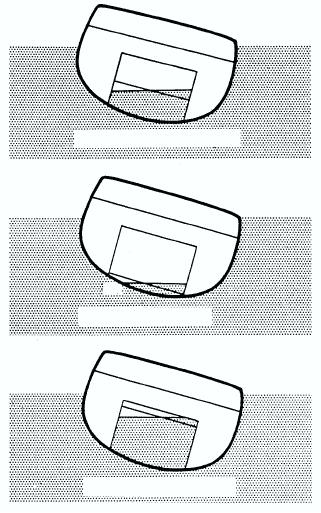
overhead and causes a reduction in the breadth of the
To begin with, the ship is floating on an even keel at
free surface.
waterline WL. Then the compartment is flooded to
waterline W1. Assuming that the water enters the
To understand how pocketing of the free surface
compartment instantaneously and that it is
reduces the free surface effect, study figure 12-29.
instantaneously frozen solid, the effects of this frozen
View A of figure 12-29 shows a compartment in
body of water are the same as if a solid weight had been
which the free surface effect is NOT influenced by the
added. The ship undergoes parallel sinkage and comes
depth of the loose water. The compartment shown in
to rest at a new waterline W1L1.
view B, however, contains only a small amount of
water. When the ship heels sufficiently to reduce the
Now suppose that an outside force acts on the ship,
waterline in the compartment from w1 to W1l1, the
causing it to heel over at a small angle of list to a new
breadth of the free surface is reduced and the free
waterline W2L2. If at the same time the liquid is freed
surface effect is thereby reduced. A similar reduction
from its frozen state, it will run toward the low side of
in free surface effect occurs in the almost full
the compartment until the surface of the water in the
compartment shown in view C, again because of the
compartment is parallel to the existing waterline
reduction in the breadth of the free surface. As figure
W2L2. A wedge of liquid is thus shifted from one side
12-29 shows, the beneficial effect of pocketing is
of the compartment to the other; as a result, the center
greater at larger angles of heel.
of gravity of the liquid is shifted from D to E. As the
center of gravity of the liquid is shifted outboard, an
additional inclining moment is created. This causes the
ship to list to a new waterline W3L3.
The additional list, in turn, causes a further shift of
w
w1
l1
the liquid in the compartment and a further shift of the
l
center of gravity of the liquid. As the center of gravity
of the liquid shifts to F, another inclining moment is
A PARTIALLY FULL
created and the ship lists even more. Eventually the
ship will come to rest with a waterline such as W4L4.
This will occur when the righting moment of the ship is
equal to the combined effects of (1) the original
inclining moment created by the outside force and (2)
the inclining moment created by the shift of liquid
w
within the compartment.
l1
w1
l
Location of Free Surface
B SHALLOW
The free surface effect is independent of the
location of the free surface within the ship. A free
surface with a certain length and breadth will, at any
w
l1
given angle of heel, cause the same reduction in GM
w1
(and, therefore, the same loss of stability) no matter
l
where it is in the ship--forward or aft, high or low, on
the centerline or off the centerline.
C ALMOST FULL
Depth of Loose Water
DCf1229
Figure 12-29. Diagram to illustrate pocketing of free surface.
The free surface effect of a given area of loose
water at a given angle of heel does NOT depend upon
the depth of the loose water in the tank or compartment,
The reduction in free surface effect that results from
unless the loose water is shallow enough or deep
pocketing is NOT taken into consideration when
enough to cause the effect known as "pocketing" of the
evaluating stability. Since pocketing improves stability,
free surface. Pocketing occurs when the free surface of
neglecting this factor in stability calculations provides a
the liquid comes in contact with the deck or the
margin of safety; however, in centerline deep tanks on
12-16

